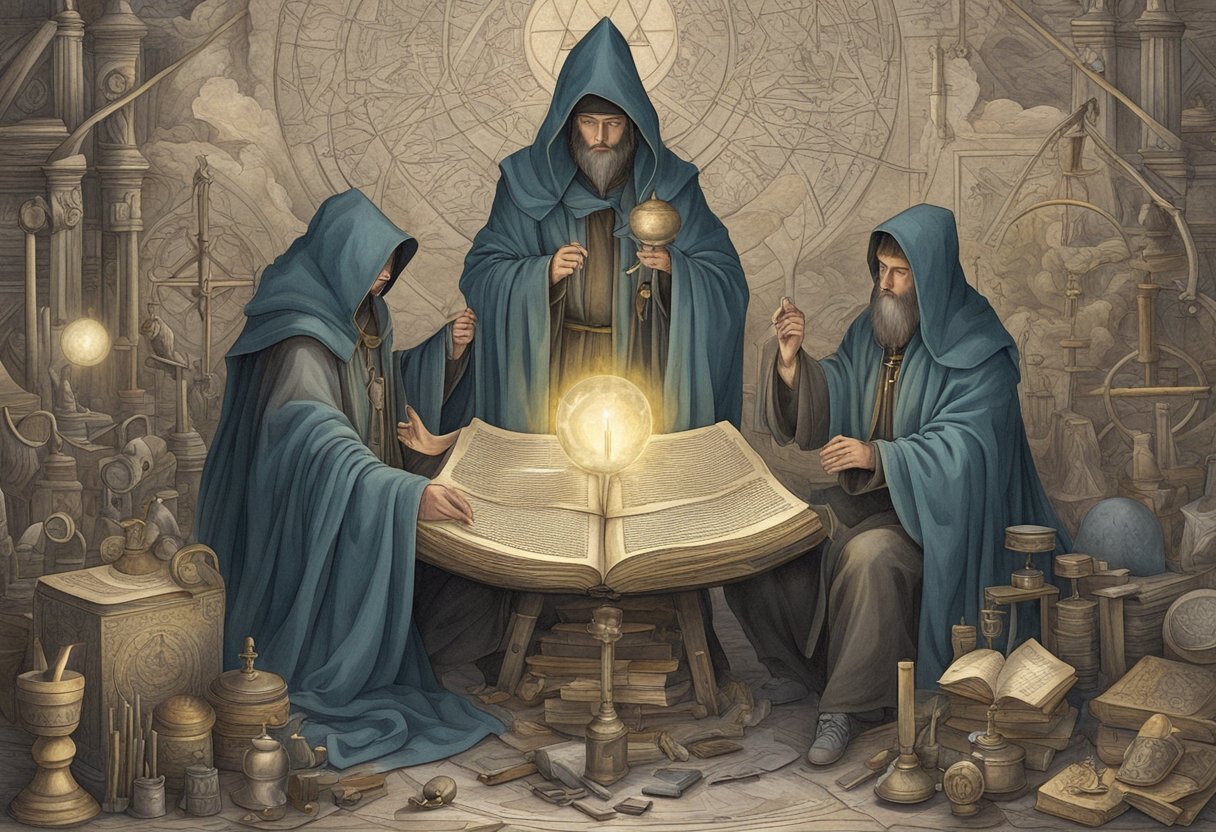The Rosicrucians represent a fascinating blend of mysticism, philosophy, and historical intrigue. Emerging in the 17th century, they have significantly influenced modern esoteric thought and spiritual movements. This secretive order, often symbolized by the Rose Cross, is steeped in a rich tapestry of ancient wisdom and cultural heritage.

Understanding the origins of Rosicrucianism reveals insights into its teachings on enlightenment, inner transformation, and the quest for deeper knowledge. Their principles have not only shaped individual belief systems but have also left a lasting mark on various cultural and spiritual landscapes throughout history.
As contemporary organizations spread the teachings of Rosicrucianism across the globe, the fascination with their beliefs continues to grow. Exploring this intriguing movement invites readers to uncover the mysteries of a group that has captivated minds for centuries.
Key Takeaways
- Rosicrucians emerged in the 17th century and have influenced modern spirituality.
- Their teachings focus on enlightenment and personal transformation.
- Contemporary organizations continue to promote Rosicrucian principles worldwide.
Historical Origins

The origins of the Rosicrucians intertwine mythology, earlier esoteric traditions, and significant developments in early modern Europe. These factors contributed to the emergence of a unique spiritual movement that has influenced various schools of thought.
Christian Rosenkreuz and Mythology
Christian Rosenkreuz is often considered the legendary founder of the Rosicrucian Order, a figure shrouded in myth. According to Rosicrucian literature, he lived in the 15th century and sought to unlock the mysteries of life and death. His alleged travels to distant lands, where he studied ancient wisdom, set the stage for the Order’s teachings.
Rosenkreuz’s symbolism, particularly the Rose Cross, blends Christian imagery with alchemical motifs. This symbol signifies spiritual rebirth and enlightenment, pivotal themes within Rosicrucian philosophy. Accounts of his life, while fantastical, are meant to inspire seekers toward inner knowledge.
Influence of Earlier Esoteric Traditions
The Rosicrucian movement drew from a rich tapestry of earlier esoteric traditions. Its teachings encompass elements of Hermeticism, Kabbalah, and Gnosticism. These traditions emphasized hidden knowledge and spiritual awakening, influencing the Rosicrucian worldview.
Key influences include:
- Hermeticism: This ancient wisdom emphasized the correspondence between the macrocosm (the universe) and microcosm (humanity), a principle adopted by Rosicrucians.
- Kabbalah: The Jewish mystical tradition offered profound insights into the nature of God and the universe, shaping Rosicrucian thought.
- Gnosticism: This early Christian movement’s focus on personal spiritual knowledge resonated with the Rosicrucian emphasis on inner enlightenment.
These influences laid a foundational framework that Rosicrucians expanded upon, integrating diverse spiritual perspectives.
Emergence in Early Modern Europe
The Rosicrucian movement first appeared publicly in early 17th century Europe with the publication of three manifestos: the Fama Fraternitatis, the Confessio Fraternitatis, and the Chymical Wedding of Christian Rosenkreuz. These texts described the existence of a secret society dedicated to spiritual and intellectual enlightenment.
During a period marked by religious upheaval and the scientific revolution, the manifestos sparked curiosity and debate. They called for a reformation of society, combining spiritual renewal with scientific advancement.
The allure of the Rosicrucians was significant, attracting scholars and thinkers. Figures like Johannes Kepler and Francis Bacon were influenced by Rosicrucian ideals. This era established the groundwork for subsequent secret societies and esoteric movements, positioning Rosicrucianism as a pivotal element of western esotericism.
Philosophy and Beliefs

The Rosicrucian philosophy encompasses profound concepts about the universe and humanity’s place within it. Central to their beliefs are ideas about cosmic laws and personal transformation through esoteric knowledge.
The Seven Cosmic Principles
The Rosicrucians identify seven cosmic principles that govern existence. These principles, derived from various philosophical and spiritual traditions, serve as a framework for understanding life’s complexities.
- Mentalism: The universe is a mental creation.
- Correspondence: “As above, so below”; there is a connection between all levels of reality.
- Vibration: Everything is in constant motion; nothing rests.
- Polarity: Everything has its pair of opposites.
- Rhythm: Cycles permeate reality.
- Cause and Effect: Every action has a reaction.
- Gender: Both masculine and feminine energies exist in all things.
These principles guide Rosicrucians in their exploration of spiritual truths and the nature of reality.
The Quest for Universal Knowledge
A core tenet of Rosicrucian belief is the pursuit of universal knowledge. This quest involves seeking truths that transcend individual experiences and cultural boundaries.
Rosicrucians draw on various disciplines such as:
- Hermeticism: Focuses on understanding the divine through nature and spiritual practices.
- Alchemy: Symbolizes personal transformation and the quest for enlightenment.
- Mysticism: Encourages direct experiences of the divine.
This holistic approach fosters a deeper connection to the universe, promoting self-discovery and personal growth.
The Practice of Mysticism
Practices of mysticism are essential in Rosicrucian life. They emphasize personal experience and direct communion with the divine. Techniques such as meditation, visualization, and prayer are often employed.
Mystical practices may include:
- Meditation: Used to quiet the mind and achieve inner peace.
- Rituals: Facilitate connections to spiritual realms and foster community.
- Healing Arts: Integrate physical and spiritual well-being.
Through these practices, Rosicrucians aim for transformative experiences that enhance their understanding of the cosmos and their place within it.
Cultural Impact

The Rosicrucian movement has left a profound mark on various cultural arenas, influencing fields such as alchemy and science, enriching literature and the arts, and shaping modern occult practices. This section explores these critical contributions and their significance.
Contributions to Alchemy and Science
Rosicrucianism played a pivotal role in the development of alchemy, merging mystical traditions with early scientific thought. It emphasized the transformation of matter and the pursuit of knowledge, which appealed to notable figures like Isaac Newton and Robert Boyle.
The Rosicrucian manifestos introduced concepts that challenged established scientific beliefs. They encouraged experimentation and observation, laying groundwork for the scientific method. Their integration of spirituality with empirical inquiry influenced the transition from mystical practices to systematic science, impacting the Enlightenment’s intellectual landscape.
Rosicrucianism in Literature and the Arts
The literary influence of Rosicrucian thought is evident in the works of renowned authors such as Goethe, Bulwer-Lytton, and Yeats. These writers infused their texts with esoteric themes, reflecting the ideals of personal transformation and spiritual enlightenment.
Rosicrucian symbolism and mythology inspired various artistic movements, notably during the Romantic era. Their doctrines placed emphasis on three key elements: mysticism, nature, and the self. Artists incorporated these elements into their works, creating a legacy that resonates in contemporary literature and visual arts.
Influence on Modern Occult and Secret Societies
The Rosicrucian tradition significantly influenced modern occult groups and secret societies, including the Golden Dawn and Theosophical Society. Their teachings fostered a renewed interest in esoteric knowledge and ceremonial magic during the nineteenth and twentieth centuries.
Many contemporary spiritual movements trace their roots back to Rosicrucian ideals, focusing on personal growth and mysticism. The emphasis on symbols and rituals found in Rosicrucianism persists in today’s practices, shaping the modalities of personal and collective spiritual exploration.
Modern Rosicrucian Organizations

Modern Rosicrucian organizations each contribute to the continuation of the Rosicrucian tradition, offering various forms of teachings and community involvement. They attract members through a blend of spiritual philosophy and esoteric practices aimed at personal development.
The Ancient Mystical Order Rosae Crucis (AMORC)
Founded in 1915 by H. Spencer Lewis, the Ancient Mystical Order Rosae Crucis (AMORC) is one of the largest international Rosicrucian organizations. It focuses on the study of metaphysical laws and encourages members to explore personal growth.
AMORC teaches through a series of lessons that cover topics such as the nature of the universe, personal transformation, and the development of psychic abilities. It offers members a structured curriculum, emphasizing practical applications of Rosicrucian principles in everyday life.
With more than 80,000 members worldwide, AMORC maintains numerous local chapters where participants can engage in group studies and activities. This connection fosters a sense of community among members.
The Rosicrucian Fellowship
The Rosicrucian Fellowship, founded in 1909 by Max Heindel, is another prominent organization within modern Rosicrucianism. Heindel’s teachings are influenced by Theosophy and focus on healing, astrology, and spiritual development.
The Fellowship emphasizes the importance of spiritual enlightenment and service to humanity. Its members study various topics, including the nature of the soul and the significance of the Rosicrucian symbols.
The Rosicrucian Fellowship offers publications and engages in public lectures, allowing members to share and expand their knowledge. The organization nurtures an inclusive environment that welcomes those who seek spiritual growth through its teachings.
Comparative Analysis of Current Groups
Modern Rosicrucian organizations vary significantly in their beliefs and practices. AMORC emphasizes metaphysical laws and structured lessons, while the Rosicrucian Fellowship focuses on healing and the influence of Theosophy.
Despite their differences, all groups share common symbols and themes, such as personal transformation and spiritual awakening. These organizations often collaborate with other esoteric movements, which enhances their experiential knowledge base.
Members interested in each organization’s approach often assess how their philosophies align with personal beliefs. This diversity within the Rosicrucian community allows for a rich tapestry of spiritual exploration and understanding.


